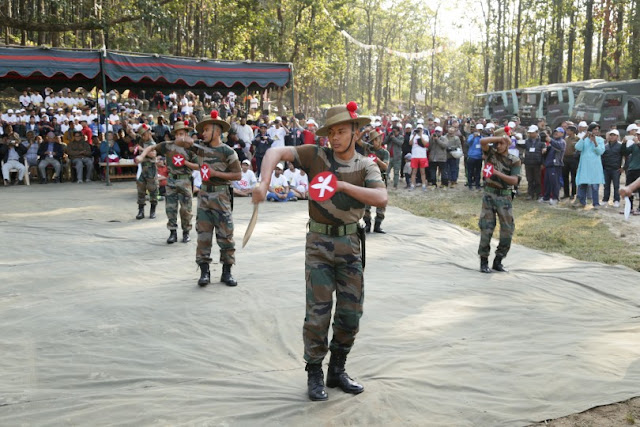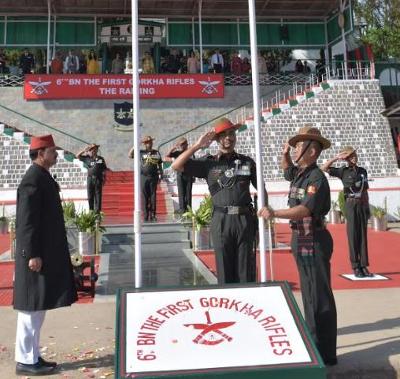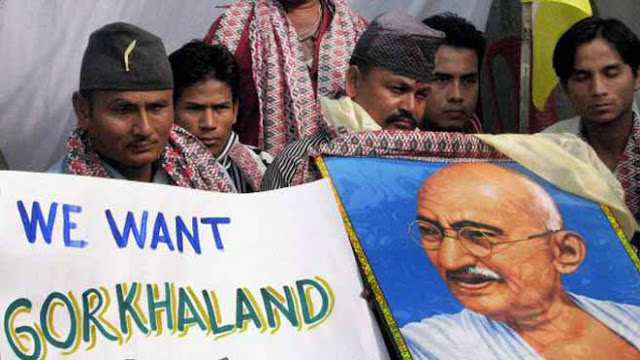THE TERM GORKHA AND ORIGIN:
There is occasional controversy regarding the term ‘Gorkha’ or ‘Gurkha’ or ‘Goorkha’. We are mostly dependent on the definition assigned by British authors. The Britishers being the holder of colonial power, always interpreted or wrote the history in their favour. An example of mis-representation is Second Anglo-Maratha war of 1720-1740, in which Chhatrapati Shau Peshwa conquered Maharashtra, Gujarat, Madhya Pradesh, Rajputana and Haryana area, but Wellesley’s account of “battle of Assaye” claimed British victory. Whereas, Indian archives, Peshwa History and memoirs of Patwardhan generals bring out the facts that Marathas inflicted heavy casualties on British forces and Marathas were the victorious. Notwithstanding the historical misrepresentation by the Britishers, one has to depend on British historians/authors .
Eden Vanisttrat defines term Gorkha (Goorkha or Gurkha) “a generic name for all the Nepalese employed in Indian Army, though strictly speaking the name should apply to those who came from regions around the district of Gorkha about fifty miles West of Kathmandu” (Notes on Goorkhas, Calcutta, 1890, page 10). Further, he mentioned in his book – “The Goorkhas” (Classical Publishers & Distributor, A/91/2, Naraina, Phase-1, New Delhi 110028), that the district of Goorkha is situated in the North-West portion of the basin of Gandak, occupying the country between the Trisulganga and Sweti Gandak. The chief town is called Goorkha and is 55 miles of West of Kathmandu. This town and eventually the district is said to have obtained its name from a very famous Saint called Gorakhnath (11th Century) who resided in a cave, which still exists in the hills in which city of Gorkha is built. Gorakhpur and Gorkhath temples in India further lend testimony to the term of Gorkha to a particular class or clan, who resided in or around the city of Gorkha, and extended their conquest far and wide over the eastern and western hills. Baba Gorakhnath was their spiritual guide. Prithvi Narain Shah (or Sahi) 1742 – is considered first powerful king of Gorkha and founder of the Gorkha dynasty. In March 1792 Lord Cornwallis entered into commercial treaty with the Gorkhas. In 1793 the Gorkhas conquered Kumaon (Uttarakhand) and their exploit in Western and Northern India started. Azad Hussain “British India’s Relation with the Kingdom of Nepal 1857-1947, George Alen and Unwin Ltd., London 1870, page 234” wrote that “the term Gorkha is applied to the majority of inhabitants of Nepal, but strictly speaking it belongs to those races who formed part of old kingdom of Gurkha, a comparatively small part of the Kingdom.” The oxford Encyclopedia Dictionary defines the term “Gurkhas” as “one of military people of Hindu descent and Sanskritik speech, who settled in province of Gurkha, Nepal, in the 18th century and made themselves supreme member of one of the Gorkha regiments of the British Army”.
 |
| Gorkha Rifles khukuri dance |
In independent India, the word “Gurkha” was changed to “Gorkha” and it was adopted so in Indian Army in Feb. 1949 (Reference History of 5th Gorkha Rifles, Chapter 12, Page 102), while changing the designation of King Commissioned Indian Officer and Viceroy Commissioned Officer to Indian Commissioned Officer and Junior Commissioned Officer (JCO) respectively.
Tracing back the history and origin of Gorkhas in India, through North-East, in brief, it dates back to many centuries. Shri B.A. Das in his book, “The Sikkim Sagar” traced the Gorkha (Lepeha) history to the year 1641. The Nagaland-Nepalese is traced to 1635 A.D. One Gorkha ‘Rai’-boy was found in a jungle near Chiechama village in Nagaland and was married to a beautiful girl of Angami class. The descendant of Rai is called Metha Trophies i.e. Non-Angami Mehtama class. Till today one of the children in the Angami class is named as “RAYI”. These facts were narrated by one Mr. Hari Prasad Gorkha Rai of Chanmari, Kohima, Nagaland and the old land-record also bear its testimony. I shall not dwell much on north-east states, since my talk is restricted to “Paschimanchal”, i.e. Gorkha dwellers in State of J&K, Punjab, Himachal Pradesh and Uttarakhand.
JAMMU & KASHMIR
Gorkhas settled in J&K in 18th Century and majority of them were those soldiers and families who had fought war alongwith Maharaja Ranjit Singh of Punjab, a great warrior, who fought many wars till his death. Gulab Singh a land-lord of Jammu was his Commander-in-Chief. After the defeat of Sikhs in their march to J&K after Afgan-war, Gulab Singh purchased Kashmir valley for Rs. 36 lakhs and became Maharaja of Jammu & Kashmir. It was Maharaja Ranbir Signh, the ruler after Gulab Singh, who organized the Army in J&K and enlisted Gorkhas. Notable amongst them were Brigadier (General Staff) Bhagat Bir Thapa, his son Brigadier Bhagwan Singh Thapa and General Khadak Bahadur of Nepal Army who migrated to J&K and was rewarded with a post of General Officer. Major Badri Nar Singh showed outstanding valour in battle of Chitral (Now in Pak Occupied Kashmir POK) and was awarded IOM. Gorkha troops also fought shoulder to shoulder, with Dogra troops in conquest of Chitral, Hunza, Nagar & Haveli (Now in POK). A familiar story is recalled in J&K of a brave Gorkha woman who swam Indus River and informed the headquarters of presence and concentration of a large force of enemy. The timely re-informcement of the troops saved the situation. She was nick-named as “Bhutni’ (devil) because of her dare-devil courage to cross Indus river at night.
Gorkha of J&K took part in Great War (1914-18) and excelled in the battle of “Beho-Beho” and “Kilmanjoo” in East Africa. Colonel (Later General) Durga Singh received gallantry award and Jagir with the honour of “Sardar Bahadur”, OBE, IOM for the bravery and extra-ordinary courage against German troops.
Gorkhas of J&K faced worst kind of communal violence in 1947-48. At that point of time, Gorkha regiments of J&K had mixed troops, and class-composition largely comprising of Mirpuri Muslims and Dogra troops. The communal frenzy and prevailing situation in 1947 made them enemies over-night. Those misguided elements (muslim troops) who joined Pakistani troops alongwith their arms and ammunition, trained their guns on Gorkha troops and completely wiped them out. Capt. Prem Singh Bist was brutally murdered at “Ban Bridge” (now in the commercial route open for trade with Pakistan) and another officer Major Ram Saran Karki was also killed while escorting Hindu refugees from Mirpur (POK). There were hardly any Gorkha survivor to tell their tales of woes and valour. During J&K OPs, 1947-48 at another front Gilgit-Sakardo, through Zozila pass , Brig. (then Major) Sher Jang Thapa fought bravely for six months with his troops seiged inside at Sakardu Fort (POK) and was awarded gallantry award of Mahavir Chakra (MVC). In 1962, Indo-China War one Havildar Sire Thapa put up a brave fight with his machine gun at Rio-Bridge (Subansari Division) and met a heroic-death. The Chinese troop burried his body on the spot and left a written note appreciating his courage and fighting qualities.
The bravery of Gorkhas were sung by street singers of Kashmir and the old Cantonment (Now J&K Police Lines and Head quarters) was named as Magar-Mall Bagh (presently the army Cantonment has been shifted to Badami-Bagh). The Gorkha- Nagar in Jammu also came into existence on the bank of River Tawi in the early fifties. The Gorkhas have to toil hard and clear the dense forest to turn the entire area to a small township (Gorkha Nagar), a small identity symbol for Gorkhas in J&K. The list of first allottees of land by Govt of J&K is annexed for the convenience of readers
The Gorkhas though have made supreme sacrifices towards integrity of India and safety of J&K, but their miseries have increased mani-folds. They are economically, socially and educationally backward. They face a great problem of getting permanent Residence Certificate (PRC) or State-subject Certificate of J&K, without which, Gorkha young boys and girls cannot get any good job or admission in educational institutes. They are kept away from the main-stream. No politician or any mainstream political party or administration care about them. Their population is about 10-15 thousand, spread over entire j&K, ncluding Kashmir Valley. J&K Govt. should take immediate step to grant them PRC because most of the families who have not been able to purchase land or house due to their poor economic condition are considered foreigners/non-state-subject. where shall they go? Bhartiya Gorkha Parisangh has an important role to play to ameliorate their sufferings. This perspective was narrated to me by Lt Col Kaloo Singh Kanwar, an Ex-officer of J&K Rfles (86 years old), presently residing at Dehradun (1, Bakralwala, Dehrdun).
PUNJAB & HIMACHAL PRADESH
I wish to club these two states because the majority of Gorkhas, who are presently living in HP, till recently, was a part of Punjab. One of the oldest associations of Gorkhas in Dharamshala (HP) was “Himachal Punjab Gorkha Association” whcih was established on 29th October, 1916. Its first President was Madho Singh Rana (Magan Pathik – Hamro Sanstha Pachachattri Barsa, Himachal Punjab Gorkha Association , page 11). The settlement of Gorkha in HP has a long history of nearly two hundred years. In this context, Shri Sat Mahajan, ex-minister of HP & MP of Lok Sabha, wrote: “the first regular settlement of in Dharmasala is known to have taken place sometime between 1879 and 1882, when the pensioners lines, some area in pine groves known as ‘Chilghari’ was earmarked for the poor pensioners. ……” (Bindu – quarterly magazine 1987, Page-17, article “Gorkhas : Personification of courage” by Sat Mahajan.)
About the earliest settlement, Grokhas settled near Village Sahura in Kangra during seige of Kangra Fort (1805-1809). In this context Shri Khushwant Singh wrote in the “History of Sikhs, Vol. 1, Oxford University Pres – 1987, at Page 1”, that Sansar Chand Katoch, ruler of Kangra had approached Maharaja Ranjit singh for help against Gorkha invasion. Ranjit Singh had no love for Sansar Chand, but feared Gorkhas, as a potential threat to Punjab, if they succeeded in taking Kangra Fort (20-24 Aug. 1809). General Amar Singh Thapa had also approached Ranjit Singh but the later spurned his request. Gorkha troops suffered from epidemic of cholera and could not face for long the might of Sikh troops. Gorkhas retired to Mandi (HP) swearing vengeance on Ranjit Singh and freed King of Mandi from the archaic rule of Sansar Chand Katoch. Later on, in the famous battle at Malaun Fort (14, 15, & 16 April, 1815), under the brave commander Bhakti Thapa (70 years old warrior), the Gorkhas inflicted heavy casualty on British Forces but succumbed to the superior weapon and artillery power of British Forces. The Gorkhas surrendered on 15th May, 1815. By then, treaty of Saguali, between Nepal and East Indian Company was in offing . Thereafter, on 24th April, first NUSSEREE (Friendship) battalion was raised at Sabathu (hp) by the Britisher and enlisted the brave Gorkha soldiers of Gen. Amar Singh Thapa, which later on became 1st Gorkha Riffles. General (Kazi) Amar Singh was considered crownless King of States (History of Sikhas by Khushwant Singh). The Gorkhas fought with British Forces at Nahan, Subathu, Maulan, Taraarh, Nalagarh, Kangra & Jatok.
Maharaja Ranjit Singh suffered reverses in his expedition to west Kashmir from Afgans in the middle July 1814, and lost his brave Commander Main Ghausa and Afghan army pushed out Ranjit Singh forces from hills. This unsuccessful campaign compelled Ranjit Singh to recruit Gorkhas in Khalsa Army because he knew that Gorkhas are excellent in hill – warfare. Gorkhas who went to Lahore for recruitment, since then has been termed Lahure (who goes to Lahore) by the Gorkhas. However, during Anglo-Sikh war 1846, the British Gorkhas faced a battalion or two of the Grokhas in the Khalsa Army. This reinforces the peculiar characteristic of Gorkhas that they serve their master and motherland faithfully, irrespective of their temporary affiliation. In March 1823, in battle of Namshera, the renowed Sikh General Phula Singh and Gorkha Commander Bal Bhadra Thapa died (History of Sikhs by Khushwant Singh).
Himachal Pradesh is very rich in Gorkha heritage, culture and custom and has many places named after Gorkha vocabulary – such as Chanmari, Cheelghari, etc. HP has unique privilege of associating with, Martyrs Durga Mall & Dal Bahadur Thapa of INA, Musician Ram Singh Thakur, Singer Mitter Sain & Master Dalip Singh (Harmonium accompaniment of Mitter Sain hailing from Joginder-Nagar). Gorkhas who had settled in the areas around Maulan fort consists the forefathers of one of the prominent families of Arjun Singh Bist, who was a former legislature from Nalagarh.
Gorkhas of Himachal Pradesh have merged well with the customs, dialect and culture of Himachal Pradesh, without loosing their own distinct mother-tongue, culture and identity. Govt of HP has created Gorkha Kalyan Board, to help the Gorkhas economically, socially and educationally. But they also live in shadow of doubt of being labelled foreigners and equally desire for a home-land for Gorkhas in the map of India, to end the identity crisis.
Dharamsala and Bakloh were home station of 1st Gorkha Rifles and 4th Gorkha Rifles till recently. Gorkha population is predominant in these two pockets of Himachal Pradesh.
UTTARAKHAND
India has a common border of about 1750 Km. with Nepal, and 20 percent of it adjoins the State of Uttarakhand. Uttarakhand is considered a natural home of Gorkha due to its geographical location, “Dev-Bhumi” for Hindus, commonality of Hindu culture, old temples and historical monuments, and above all the dwelling of about 10 lakhs Gorkhas, spread over in 13 districts of Uttarakhand. Uttarakhand is linguistically and culturally divided into two mandal; Garhwal and Kumaon mandal.
Gorkha influence in this region can be traced back to 1119 AD, when a Raja from Mall Dynasty of Nepal erected a ‘TRIHUL’ at Rudranath- Shiv Mandir at Gopeshwar, Chamoli (Uttarakhand), the mention of which has been made in the broucher of National monuments, published by Archaeological Survey of India, Dehradun – 2008 at page 6.
The history of Gorkhas settlement in Uttarakhand goes as back as to two hundred years. The district of Kumaon went to the hands of Gorkha General Amar Singh Thapa in the year 1790. A fort “Bhauali-ki-Garh” exists at Pithoragarh even today, with inscription of its construction during 1790., Govt of Uttarakhand at the request of Gorkhas through the efforts of a political party, Gorkha Democratic Front, has indicated it to be a protected monument alongwith Khalanga site, where Anglo-Gorkha war took place in the year 1814. At Khalanga battle-site, a Gorkha war Memorial (45 feet high’satup’) is being constructed by Govt of Uttarakhand. The site is expected to draw tourists from all-over the country and abroad, besides its historical importance. The inauguration of Gorkha War Memorial is being planned at a large scale in the near future after completion of the works.
Gorkhas fought with British Forces at three places/forts : (1) Khalanga (2) Almora (3) Khurbura (Dehradun) in Uttarakhand.
All India Gorkha league under the Presidentship of Thakur Chandan Singh of Dehradun, was formed at Dehradun on 15 Feb. 1924.
The important sites are : Gangotri Shiv Temple (constructed by General Amar Singh Thapa), Gopeshwar Shiv Temple, Datkali Mandir (Tamar – Pattar awarded by Commander Bal Bhadra Thapa), Jhandaji Darbar Sahib (Tamar – Pattar awarded by Commander Bal Bhandra Thapa), Ghuchukpani (natural spring-water), Ghate-khola, Nalapani etc. (common name given by Gorkhas.
Shaheed Maj. Durga Mall (INA) and Kharga Bahadur Bist, Dandi marcher along with Mahatma Gandhi, are inspiration to Gorkhas in Uttarakhand Gorkha organisations : (1) Gorkhali Sudhar Sabha, 17th April, 1938, (2) All India Gorkha Ex-serviceman Welfare Association established in the year 1950, by Ministry of Defence to help out Gorkhas, educationally and socially. Shri Ari Bahadur Gurung was its founder-President and Shri D.S. Thakur from Shimla was its first General Secretary. Their far-signtedness has created this prestigious organisation, (iii) Khalangan Bal Bhadra – Vikas Samiti, (iv) All India Nepali Bhasa Samiti, (v) Uttarakhand Nepali Bhasa Samiti, (vi) Nepali Parshad, (vii) ‘Gurans’ Sanskiriti Kala Manch, (viii) Gorkha Democratic Front, a political voice of Uttarakhand Gorkhas.
PROBLEMS FACED BY GORKHAS:
The first and fore-most is Indianness of Uttarakhand Gorkhas. The major community in Uttarakhand, more often that not, view Gorkhas as citizens of Nepal, not withstanding their moorings in Uttarakhand for the last two centuries or more. No main-stream political party openly espouses the cause of Gorkha for the fear of back-lash of major community, in vote-bank politics. The proximity and open border (approx. 170 Km.) with Nepal has caused a thin veil of suspicion to the Indainness of Gorkha in Uttarakhand.
One Karam Chand Baral in Pithoragarh has been denied approval of his building plan, inspite of the fact that he owns a land, mutated in his name in land/revenue records. He has been branded out-sider and faces an eviction notice issued by District officials. Gorkha Democratic Front came to his rescue and the matter has been put in abeyance and hopefully, it shall meet its natural death.
46 families in Uttarkashi suffered due to withdrawal of their ration card, gas connection etc. The mater was forcefully raised by GDF and since then it has subsided.
Nepali labourers are murdered, cut into pieces and thrown in jungle. Persecution of Gorkhas occasionally take place mostly in Tueni, Chakrata, Uttarkashi, Chamoli and Pithoragarh districts.
Even those who are bonafide residents of Uttarakhand are branded outsiders. One Gorkha municipal Parishad from Rishikesh faced embarrassment on this score.
Exploitation by main-stream political parties as a vote-bank without any reward.
By:- Lt Col (Retd) V K Sharma, Advocate, President – Bharatiya Gorkha Parishangh, Dehradun, vksharmaadvocate1@gmail.com
Via thegorkha








%2Band%2Bhis%2Bson%2BKarna%2BRaj%2BSubba%2B(31).jpg)







.jpg)


